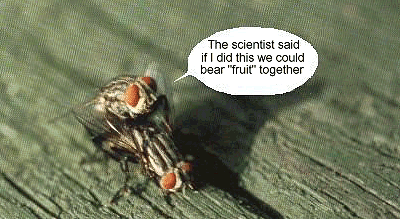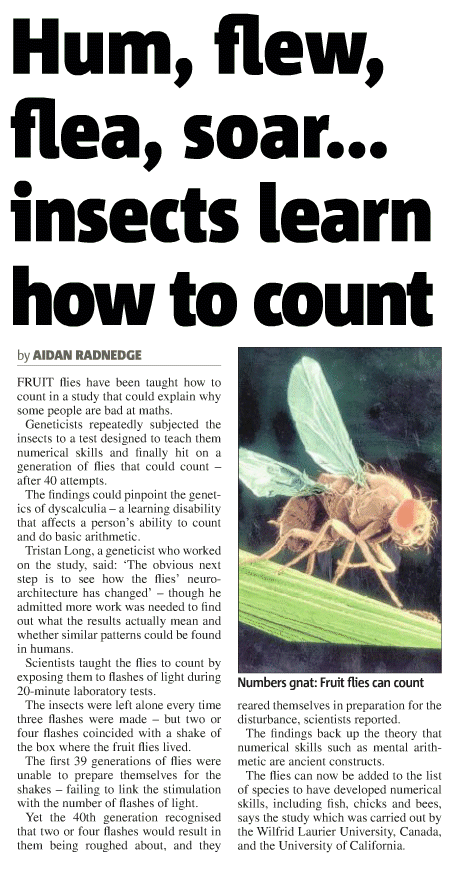
The latest buzzword in remote controls |
As alert as ever on just 2 hours sleep a night

WHY do we have to spend a third of our lives sleeping? The discovery that fruit flies with a particular protein variant need only a third of the normal amount of sleep could provide part of the answer.
Surprisingly, sleep in flies and mammals shares many similarities; deprivation, for instance, leads to impaired performance. Chiara Cirelli's group at the University of Wisconsin-Madison has been screening thousands of mutant fruit flies to identify the genes that affect slumber.
She discovered that one mutant, dubbed "minisleep", rests only 4 hours a day, compared with 12 hours in normal flies (Nature, vol 434, p 1087). Despite the lack of sleep, minisleepers showed no signs of impairment. Their escape responses also remained almost as quick after 24 hours without sleep, unlike those of normal flies.
The minisleep mutation is in a gene called Shaker, which is also found in mammals, and there are a few reports of people who really do seem to get by on a couple of hours' sleep without any ill effects. Understanding how the protein variant works might lead to new kinds of drugs for keeping sleep-deprived people alert, the team speculates. There is a snag, though: minisleepers die young.
Stephen studied physics in Oxford, idleness in Princeton, and astrophysics at Imperial College, London. After three years editing News & Views at Nature, he moved to New Scientist in 1998 to edit features, and then run the section. Having demoted himself to consultant he now writes for all parts of the magazine.
Experts open flies for clue to sexuality
BY SUZY AUSTIN
A MASTER gene which switches sexual behaviour has been discovered by scientists-in a fruit fly.
Tampering with the genetic key makes females behave like males, chasing other females, wooing them by tapping their abdomens and performing wing-beating serenades.
They are turned off by male advances, kicking and flicking the would-be lovers. Disabling the master gene in a male fly turns him into a hopeless suitor with no interest in the females.
And, because fruit flies share many genes with humans, the same could happen in men and women.
'Human sexual behaviours could also have a basic circuitry in the nervous system that mediates attraction and mating,'
said researcher Professor Bruce Baker from Stanford University, California. 'We created a powerful and novel way to manipulate an interesting gene - a gene that governs lifestyle and the whole courtship sequence.' Specific genes are already known to rule basic sexual instincts, he added. The research is published in Nature journal
COCKROACHES help explain why 'women who delay having children are
less fertile, research suggests. Their eggs are lost through natural
cell deaths if they do not mate 'because
evolution cannot adapt', researchers said. However, humans put off having
families because of cultural influences, the
Manchester University study in Evolution
and Development says.
[metro_files Jun16,2005]
New animal species evolved in an instant
18:24 27 July 2005
Bob Holmes
A new species of insect may have arisen in an evolutionary eye-blink as a result of cross-species mating. The discovery suggests that hybridisation - well known to be an important force in producing new plant species - may also be widespread in animals. Until now, it had been assumed that new animal species almost always arise by gradually splitting off from an existing lineage.
The probable new species belongs to a group of flies known as fruit maggots – highly specialised fruit parasites in which each species infests its own particular plant species.
In 1997, Bruce McPheron and his colleagues at Pennsylvania State University in University Park, US, noticed a fruit maggot infestation on introduced Asian honeysuckle bushes in north-eastern Pennsylvania. Since the host plant had only been in North America for about 250 years, the researchers decided to investigate how it ended up with such specialised pests.
They found that, genetically, the honeysuckle maggots looked like the result of hybridisation between two fruit maggot pests of native species, the blueberry maggot and the snowberry maggot. For example, earlier studies had shown that each of the latter two species bore certain unique gene variants found in no other fruit maggot species - yet the honeysuckle maggots carried variants from both blueberry and snowberry maggots.
A hundred generations
The honeysuckle maggots are not first-generation hybrids, however. First-generation progeny should have exactly half their genes from one parent species and half from the other. Instead, the honeysuckle maggots have a wide range of ratios, indicating they have been breeding among themselves for at least a hundred generations.
The Penn State University team, this time led by Dietmar Schwarz, have now studied five different locations - some widely separated geographically - and in every one the maggots on honeysuckle show these traces of hybridisation. "That suggests there must be something to hybridisation that makes them colonise honeysuckle," he says.
Once the hybrids settle into their new home, they are unlikely to interbreed much with the parent species, because fruit maggot adults mate on their host plant. As a result, this host shift should lead rapidly to the formation of a new species. The researchers are not yet willing to declare the honeysuckle maggot has completed this process, Schwarz says, because they have not ruled out the possibility of a low level of interbreeding with at least one of the parent species.
If hybridisation often leads to shifts in host preference, it could be much more important in animal evolution than anyone had suspected, says Schwarz. After all, many - perhaps even most - animal species on Earth live in tight association with a particular host. "It makes one think it is possible for hybridisation to be important in generating biodiversity," says Thomas Dowling, an evolutionary biologist at Arizona State University in Tempe, US.
Journal reference: Nature (vol 436, p 546)

Synthetic 'upgrade' for fruit fly's DNA
16:00 13 August 2012 by Linda Geddes For similar stories, visit the GM Organisms and Genetics Topic Guides The genetic code of the fruit fly Drosophila has been hacked into, allowing it to make proteins with properties that don't exist in the natural world. The advance could ultimately lead to the creation of new or "improved" life forms in the burgeoning field of synthetic biology. The four letters of the genetic code, A, C, T and G, are read in triplets, called codons, by the cell's protein-making machinery. Each codon gives an instruction for the type of amino acid that gets added next in a protein chain, or tells the machinery to stop. Jason Chin at the Medical Research Council Laboratory of Molecular Biology in Cambridge, UK, and colleagues previously showed that it was possible to reassign one of these stop codons to incorporate an "unnatural" amino acid instead, and last year they engineered nematode worms to manufacture such proteins. Complex proposition However, fruit flies are a much more complex proposition. "They contain significantly more neurons; they can learn; they have all sorts of complicated behaviours," says Chin. "Many of the things we've discovered in biology have actually been discovered in flies." Now, as a proof of principle, Chin's team has engineered fruit flies that incorporated three new amino acids into proteins in the cells of their ovaries. The flies were engineered using bacteria that had been modified to insert the genetic code for the unnatural amino acid into the fly DNA. There was no apparent impact on the flies' health, and they even produced healthy offspring that also made the new protein chains. "This work provides a very significant expansion on our capability to manipulate and alter proteins involved in specific cellular and developmental processes. It will provide new insights into human disease mechanisms, memory and ageing," says Paul Freemont of the Centre for Synthetic Biology and Innovation at Imperial College London. Bulletproof flies None of the amino acids were particularly remarkable, but the fact that engineering the flies had no obvious impact on their health suggests that many more useful amino acids could be similarly incorporated. For example, work in bacterial cells has shown that it is possible to incorporate unnatural amino acids that cross-link to each other or turn an enzyme's activity on or off when a light is shone on them. Doing this in a complex organism like a fly could shed new light on how proteins interact within cells, or how rapidly turning an enzyme on or off affects the cell's function. The technique could even be used to create animals with new or improved properties, although that is probably some years off. "We're not going to be creating bulletproof flies or anything like that in the short term," says Chin. Journal reference: Nature Chemical Biology, DOI: 10.1039/nchembio.1043 |